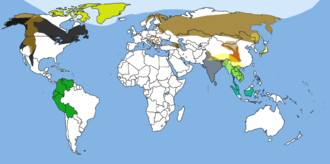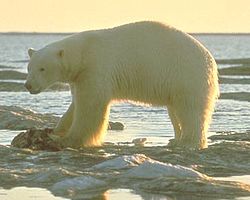Bear
Bears (singular: bear) are a group of large mammals found all over the world in many different habitats. They form the family Ursidae, in the suborder Caniformia of the order Carnivora. There are 8 living bear species.
- Family Ursidae: Bears
- Giant panda, Ailuropoda melanoleuca
- Spectacled bear, Tremarctos ornatus
- Brown bear, Ursus arctos
- Polar bear, Ursus maritimus
- American black bear, Ursus americanus
- Moon bear, Ursus thibetanus or Selenarctos thibetanus
- Sloth bear, Melursus ursinus
- Sun bear, Ursus malayanus
| Bears Temporal range: Late Eocene – Recent
| |
|---|---|

| |
| Brown bear from Kodiak, Alaska | |
| Scientific classification | |
| Kingdom: | Animalia |
| Phylum: | Chordata |
| Order: | Carnivora |
| Infraorder: | Arctoidea |
| Family: | Ursidae G. Fischer de Waldheim, 1817 |
| Subfamilies | |
|
†Amphicynodontinae | |
Appearance
Bears usually have a big body with short and thick legs. They have a broad head and a very short tail. They have small eyes and round ears. They usually have longer, shaggy fur. On each foot they have five claws, which they cannot pull back. They use their claws for digging, climbing, and hunting. They can stand up on their back legs and their front paws are flexible. Usually bears can climb and swim very well. Males are usually bigger than females. Most bears except the giant panda are only one color. Most bears are russet, brown, or black.
Bears do not have good hearing. They have powerful senses of smell and sight. They have good sight and can see colors, which is different from other carnivores. Bears mostly use their sense of smell to know what is around them. They can smell better than dogs.[1] Bears also have good memory, which lets them remember where they can find food.
Life
They are mostly active at night, except for the Polar Bear. Some bears hibernate, meaning they sleep during the winter to save energy.
Bears are usually omnivorous, which means that they eat plants and meat. They eat berries, grass, and fish. An exception is the polar bear, which eats mostly meat.[2]
Bears usually live alone, except when they are mating season or if they have cubs. The father does not raise the cubs. The mother raises the cubs for months or a few years depending on how much food there is. The mother protects her young, even at the cost of her life.[3]
Distribution
| Wikispecies has information on: Ursidae. |
Bears live all over the world, mostly in the Northern hemisphere. They are found in North America, South America, Europe, and Asia. There used to be bears in northern Africa but they are now extinct.[4]
In popular culture
| Wikispecies has information on: Ursidae. |
Some fictional bears in popular culture include Yogi Bear, The Berenstain Bears, and Winnie the Pooh.
| Wikimedia Commons has media related to Lua error in Module:Commons_link at line 62: attempt to index field 'wikibase' (a nil value).. |
Bear Media
Plithocyon armagnacensis skull, a member of the extinct subfamily Hemicyoninae from the Miocene
Fossil of the cave bear (Ursus spelaeus), a relative of the brown bear and polar bear from the Pleistocene epoch in Europe
Polar bear mother nursing her cub
References
- ↑ "Eyes of the Bear, Alaska Department of Fish and Game". www.adfg.alaska.gov. Archived from the original on 2019-01-01. Retrieved 2019-01-05.
- ↑ "Bear's Food and Diet". BearSmart.com. Archived from the original on 2018-11-06. Retrieved 2019-01-05.
- ↑ "Bear Reproduction". BearSmart.com. Archived from the original on 2018-10-21. Retrieved 2019-01-05.
- ↑ "Bear distribution map – Bear Conservation". Archived from the original on 2019-04-04. Retrieved 2019-01-05.









